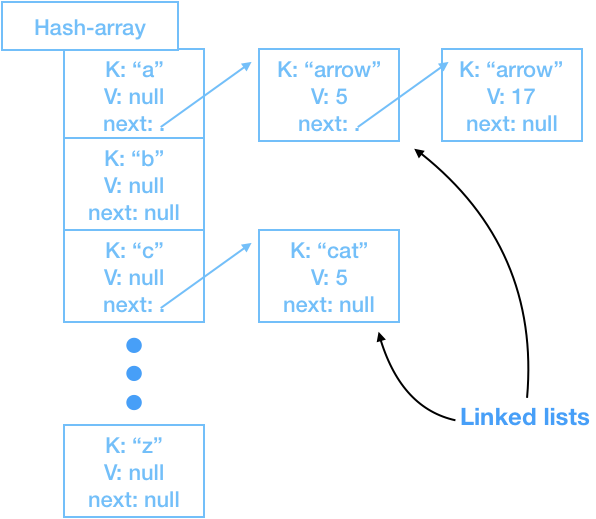Make a hash map (dashamap), your future self will be grateful after that fateful interview
Build a hash-map. The idea is to have an array of nodes, each node them having a linked-list behind it.
Well, your first hashing function is this:
private String HashFunctionOne(String input) {
if (input.length() > 0) {
return String.toLowerCase(String.valueOf(input.charAt(0)));
}
return nil;
}And since you have a list of words, some of which have the same first letter (character), you will have hash collisions when you insert a second word in the same bucket. That's why you have a linked list which is attached to the end of the list when you insert/set a word.
And your second hashing function is:
private String HashFunctionTwo(String input) {
if (input.length() > 0) {
return String.toLowerCase(String.valueOf(input.charAt(1)));
}
return nil;
}and your third hashing function is:
private String HashFunctionThree(String input) {
if (input.length() > 1) {
return String.toLowerCase(String.valueOf(input.charAt(0)+input.charAt(1)));
}
return nil;
}You'll be writing three different classes, one for each hashing function. Call them DashaMapOne, DashaMapTwo, & DashaMapThree.
Build a test harness that can read in the word list and insert each word into each of the three hash-maps.
Each of the classes should implement this interface:
interface HashMapX {
// fundamentals
public void set(String key, String value);
public String delete(String key);
public String get(String key);
public boolean isEmpty();
public long size();
// testing access
protected boolean bucketSize(String key); // used for tests
}When you create the constructor for each class, you need to create an array of Node
objects. Each Node should look like:
Node:
k: String
v: Integer
next: Node
the hash-array needs to get initialized to 26 long of Node, with each value being 'a'..'z'.
read in the list of words in wordlist.txt. Each word is on it's own line, with a value,
and as each word is read, insert it into each of the three hash-maps, using the word as the key,
and integer value as the value.
When you set a word/value pair: (this is pseudocode)
- set(key, value) {
key-hash = hash-function(key)
newval = new Node(key, value)
append-to(hash-array[key-hash], newval)
}
append-to is a method that attaches the created node with the word as the key, the integer as the value,
at the end of the linked list attached to the hash-array head list-pointer.
When you get a word/value pair:
- value get(key) {
key-hash = hash-function(key)
newnode = find-in(hash-array[key-hash], key)
return newnode.v
}
find-in(array-slot, key-word) returns the Node that contains the key-word in the k field.
(you may want to just do a simple linear search to find the node that has the key in it).
and the Hard One is delete(key-word)
oy. that's enough.
If you can figure out a way to make your implmentation GENERIC, you get 2.75million extra points. That's enough to get the level 3 prize, or a very old, tattered, online copy of Think Data Structures in Java
